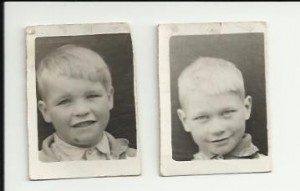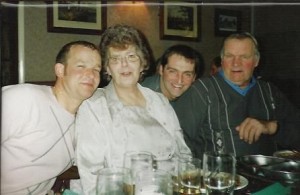Derick Craggs is one of 12 children – nine boys and three girls – born in Hessle House and brought up in Broughton. He is the only one still living in the parish.
Hessle House was one of only two houses in the village so far lived in as a home by Derick. He and Doreen moved into 10 Beech Crescent some six months after their wedding at St Mary’s, Old Malton, in January 1967.
The Craggs were the last family to live in Hessle House, a large 3-bedroomed farmhouse which was knocked down in the early 1990s. Derick’s parents moved in when his father James Oscar got work at Oak Farm, then owned by Guy Raines who bought the farm at auction in 1934.
Derick’s father originated from the Ebberston area while his mother Rene (nee Douthwaite) hailed from the Skinningrove area.

Left back, Derick, Les, Ernie, Ray, Dave. Left front, Jim, Mary, Stan, Tom, Gladys, Harold, pictured in the 1980s
The eldest of their children was Gladys May born in July 1931. The youngest was Thomas William, born November 1950. Between them came James Edwin; Alfred Ernest; Leslie Dennis; Ida Mary; Stanley Richard; Derick Alan; Joan Mary; John Raymond; David Anthony; and Harold Oscar.
Sadly Joan was knocked down by a bus at Hill Top on the B1257 on the 11th May 1953. She was crossing the road in The Dip cycling home from school.
Doreen, nee Hall, was born at Welburn near Kirkbymoorside. She gave up her full time job working in the butchery department at the Co-op in Norton to look after her family. She later worked part-time, working for Mrs Sykes at Broughton House as well as helping with the potato harvest at Oak Farm.
Derick followed his father into farming at Oak Farm where he worked for 50 years. Most of his brothers spent some time working on farms. Stanley, who lived in Manor Park until the mid 2000s when he moved to Norton, worked at Holme Farm for Ken Potter for more than 10 years until going into the timber trade.
Always a mixed farm, Oak Farm expanded several times over the 20th Century, including when Hessle Farm became part of it. Hessle is thought to once have belonged to Old Malton Priory,
Kelly’s Trade Directory states Hessle House (once also known as Hazel House) had tenant farmers but by 1913 is shown under the name of John William Studley Potter who then owned Oak Farm. Derick explained that Hessle was a big farm in its own right, much larger than the early Oak Farm. Over the century Oak Farm expanded from about 300 acres to 500 acres when Plantation Farm and Woodhouse Farm were added.
Among the biggest changes was the switch from one-horsepower to 160 horsepower by the 21sC and the reduction in manpower, down from 8 full time workers when Derick started farming to only one full-time worker when he retired.
When Oscar began working, there were 6 or 8 horses, some stabled at Oak Farm, the others at Hessle House. Initially the horses were joined by two or three small grey Ferguson tractors each capable of 25 bph. By the mid 20thC there was one horse left and the small tractors replaced by ever larger ones, until the 21stC when there were just 4 tractors, the largest being 160 bhp.
Small stone or brick built buildings, difficult to access with modern equipment, were replaced with large barns. These were seen as a huge improvement. Another massive improvement over the century was crop yields.
But not all the changes were for the better in Derick’s eyes.
He says he was “never a fan of spraying – you don’t know what harm it’s doing” and recalls with fondness the sweet smelling hay from flower-rich fields, now replaced with grass-only land which becomes haylage or silage.
But life was not always easy.
Derick can now smile as he remembers those times Hessle House was flooded – sometimes with little or no warning when the nearby River Rye rose unnoticed during the night. Until the flood banks were built in the late 40’s/early 50’s, there were times when he and his siblings were trapped upstairs. They had to be lowered from the bedrooms by other farm workers. He recalls many a time the emergency move into the temporary accommodation in Oak Farm Granary. Here they bedded down on corn heaps and straw bales with mice and rats running over them. Their life at Hessle House, sharing a double bed, one of three in one bedroom, each occupied by two brothers, was by comparison luxury!
Signed on as the under-stockman (known as a bullakee?), Derick learnt his trade as he worked. He could turn his hand to any job and was often called upon by fellow parishioners to help out with minor jobs, “specialising” in fencing!
He became particularly adept at climbing through windows: the first effort was when at the age of 13 years he was hoisted through a small ground-floor window to search the old cottage at Oak Farm for his immediate “boss” the senior stockman Ted Warriner. Derick found the suicide note which confirmed the reason for Ted’s death by drowning in the River Rye in 1953.
Some 40 years later he was climbing through the window of the bedroom of the late Mrs Ruth Raines when she was accidentally locked out of Oak Farmhouse. His rescue meant leaving large dirty footprints on a very expensive carpet but instead of the anticipated telling-off, Derick was presented with a box of chocolates in thanks.
Derick also recalls the excitement in the village on the night the barn full of hay was found to be ablaze one tea time. No cause was ever determined but Derick believes it was a carelessly discarded cigarette end.
Derick and Doreen have two sons, Desmond Alan and Darryl John. Des married Mandy and they have a daughter Shaunna. Darryl married Elize and they have two children,Logan Lee and Layla Mae.
Over the years Derick liked a game of darts and playing cricket.
He fondly remembers Broughton’s cricket ground, then cared for by grounds-man Tommy King of Broughton House, and rues the day the cricket field was given back to sole agricultural use.
Doreen enjoyed line-dancing and gardening.
Photos provided by Derick and Doreen Craggs.
AGW 2011

